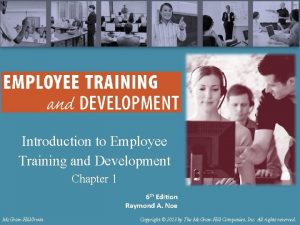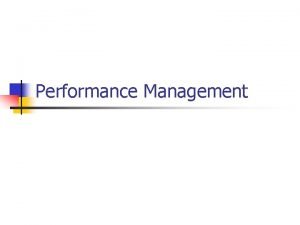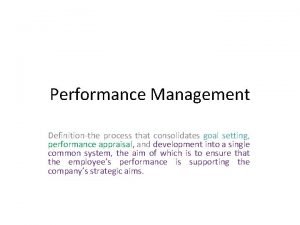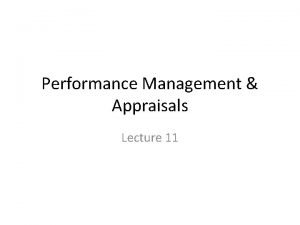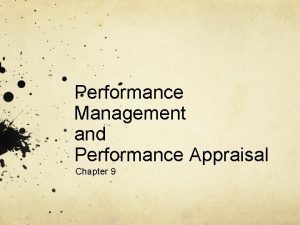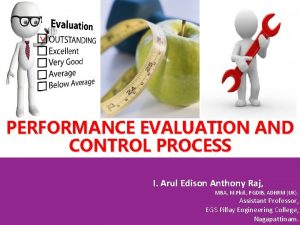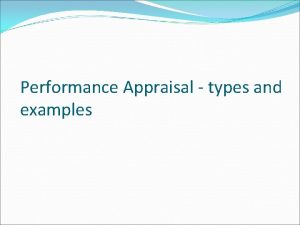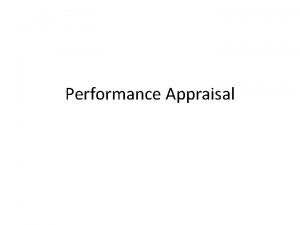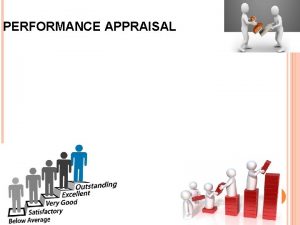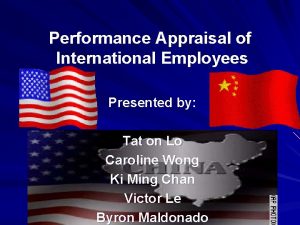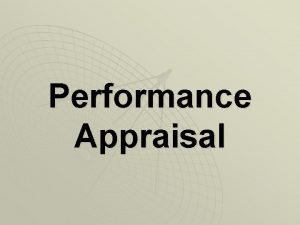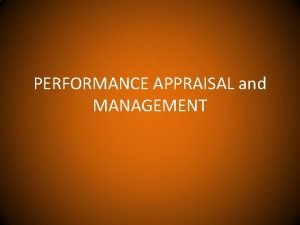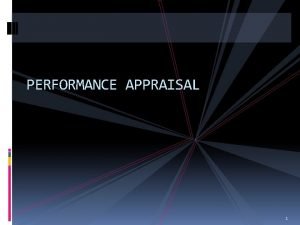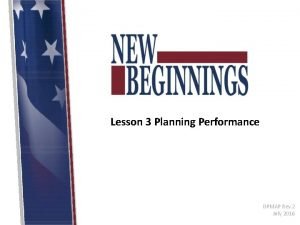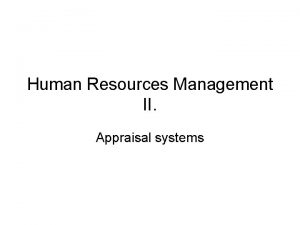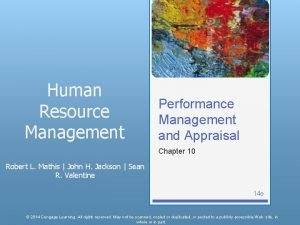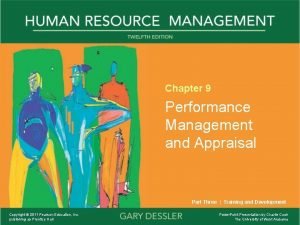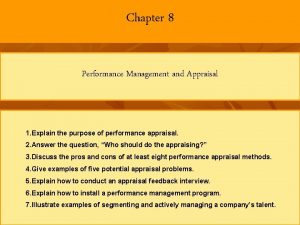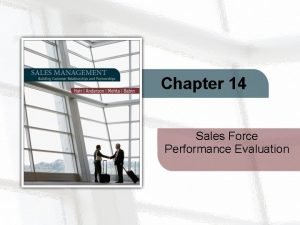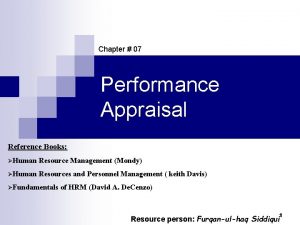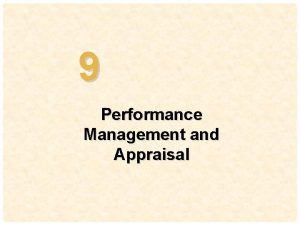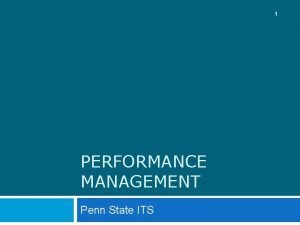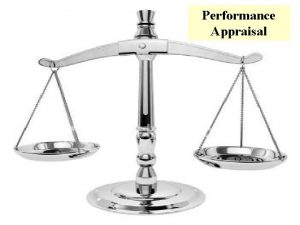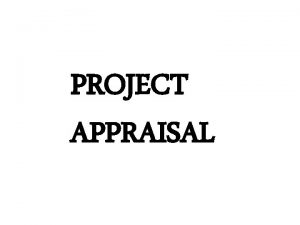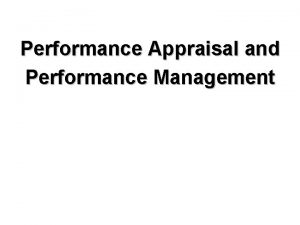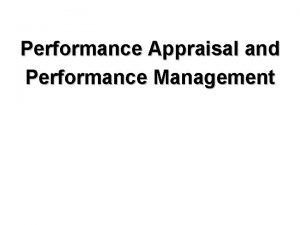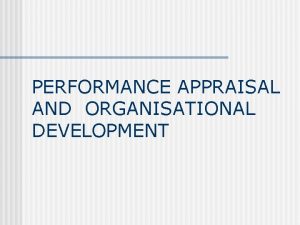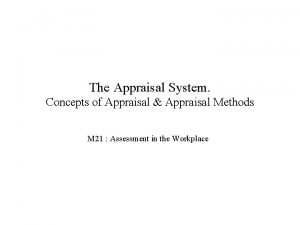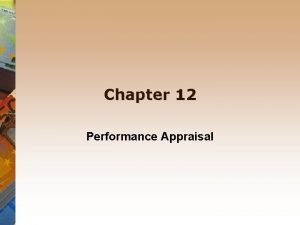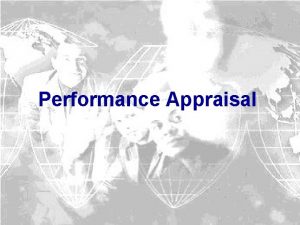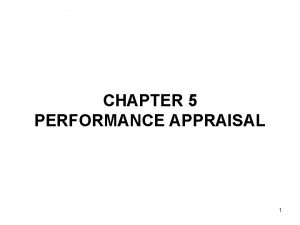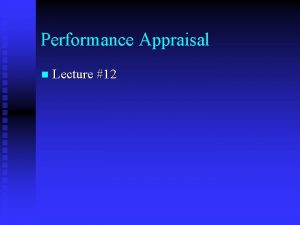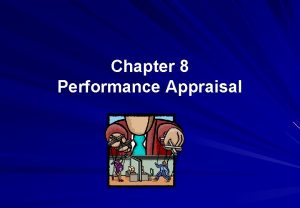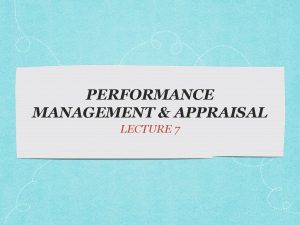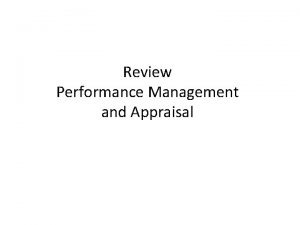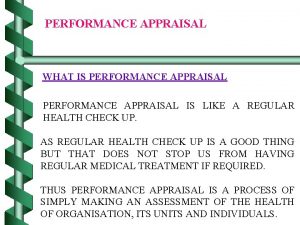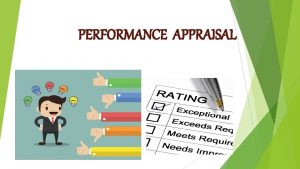TRAINING DEVELOPMENT PERFORMANCE APPRAISAL TRAINING INTRODUCTION Performance appraisal



























- Slides: 27

TRAINING & DEVELOPMENT PERFORMANCE APPRAISAL & TRAINING

INTRODUCTION • Performance appraisal is an evaluation of the performance of an employee against the job standards in terms of quantitative, qualitative and behavioural aspects at the workplace. • A successful PA process involves explaining the job, communicating expectations, observing and documenting behaviour and providing frequent informal feedback.

Why PA ? • It helps the supervisor and the employee to – – Understand individual strengths & weaknesses of performance – Mutually understand expectations for performance – Form a basis for personnel action – Determine training & development needs of employees

PERFORMANCE APPRAISAL AND TRAINING NEEDS • Review org. goals to associate preferred org. results in terms of units of performance i. e. quality, quantity, cost or timeliness. • Specify desired results for the domain, gives guidance & focus on results needed by other domains Learning goals • Prioritize the range of results needed from the employee helps the supervisor understand what training needs to be given.

PERFORMANCE APPRAISAL AND TRAINING NEEDS • Identify measures to evaluate if an how well the domain’s desired results were achieved. • Identify standards for evaluating how well the desired results were achieved. • Document a performance plan – desired results, measures and standards. • Conduct ongoing measurement to track the performance of the employee.

PERFORMANCE APPRAISAL AND TRAINING NEEDS • To provide an opportunity for the employee for introspection, Self-evaluation and goal-setting so that he remains on the path of development. • To prepare the employees for higher jobs by reinforcing development of behaviour & qualities for these higher level positions. • To generate relevant data on each employee periodically. • To enable employee to adopt the norms and values of the organization and develop commitment.

PERFORMANCE APPRAISAL PROCESS • Done on certain criterions or standards fixed in advance. • Employee should be aware of those yardsticks. • Steps in PA – – – Establishing standards Communicating stds. to employees Measuring actual performance. Comparing actual with stds. Discussing reports with employees Taking corrective action

Performance Appraisal Methods • Individual Evaluation Methods – Confidential report – Essay evaluation – Critical incidents – Checklists – Graphic rating scale – Behaviorally anchored rating scale – MBO

Performance Appraisal Methods • Group Appraisal – Ranking – Paired comparison – Forced distribution – Performance tests – Field review technique

Performance Appraisal Methods 1. Confidential report 2. Essay evaluation 3. Critical incidents 4. Checklists 5. Graphic rating scale 6. Straight Ranking 7. Paired comparison 8. Forced distribution 9. Grading system 10. Field review technique 11. Nominations 12. Work samples Traditional methods

Performance Appraisal Methods Modern methods 1. Assessment centre 2. Human resource accounting – costs & contribution 3. Behaviorally anchored rating scale 4. MBO 5. 360º performance apparaisal

Critical Incident method Ex: A fire, sudden breakdown, accident Workers reaction A B C D E informed the supervisor immediately Become anxious on loss of output tried to repair the machine Complained for poor maintenance was happy to forced test scale 5 4 3 2 1

Checklist method Simple checklist method Weighted checklist method Forced choice method Simple checklist method: Is employee regular Y/N Is employee respected by subordinate Y/N Is employee helpful Y/N Does he follow instruction Y/N Does he keep the equipment in order Y/N

Weighted checklist method Regularity Loyalty Willing to help Quality of work Relationship weights performance rating (scale 1 to 5 ) 0. 5 1. 5 2. 0

Forced choice method Criteria 1. Regularity on the job • Always regular • Inform in advance for delay • Never regular • Remain absent • Neither regular nor irregular Rating Most Least

Graphic Rating Scale • • Continuous Rating Scale Discontinuous Rating Scale Employee name_____ Deptt_______ Rater’s name ______ Date____ ------------------------------------Exc. Good Acceptable Fair Poor 5 4 3 2 1 _ Dependability Initiative Overall output Attendance Attitude Cooperation Total score Continuous Rating Scale

Discontinuous Rating Scale Indifferent Enthusiastic Attitude No Interested Very enthusiastic

BARS( behaviorally Anchored rating scale) Step 1. Identify critical incidents Step 2. Select performance dimension Step 3. Retranslate the incidents Step 4. Assign scales to incidents Step 5. Develop final instrument

MBO Process • • Set organizational goals Defining performance target Performance review feedback

Performance Appraisal Methods • Group Appraisal – Ranking – Paired comparison – Forced distribution – Performance tests Field review technique

Ranking method Employee Rank A 2 B 1 C 3 D 5 E 4

Paired comparison method A A - B - C - D + E Final Rank + 3 B + - - + + 2 C + + - + + 1 D - - + 4 E - - - 5 No of Positive evaluation Total no. of evaluation * 100 = employee superior evaluation

Forced Distribution method No. of employees 10% poor 20% 40% Below average 20% 10% good Excellent Force distribution curve

Field review method Performance Dimension subordinate Leadership Communication Interpersonal skills peers superior customer ^ ^ ^ Decision making ^ ^ ^ Technical skills ^ ^ ^ Motivation ^ ^ ^

Performance criteria for executives • For top managers – Return on capital employed – Contribution to community development – Degree of upward communication from middle-level executives – Degree of growth and expansion of enterprise.

For middle level managers • Departmental performance • Coordination among employees • Degree of upward communication from supervisors • Degree of clarity about corporate goals and policies

For supervisors • Quality and quantity of output in a given period • Labor cost per unit of output in a given period • Material cost per unit in a given period • Rate of absenteeism and turnover of employees • No of accidents in a given period
 Chapter 11 performance appraisal - (pdf)
Chapter 11 performance appraisal - (pdf) Disadvantages of bell curve in performance appraisal
Disadvantages of bell curve in performance appraisal Introduction to employee training and development
Introduction to employee training and development Traditional method of performance appraisal
Traditional method of performance appraisal Swot analysis of performance management system
Swot analysis of performance management system Management by objectives performance appraisal
Management by objectives performance appraisal Absolute and relative performance appraisal methods
Absolute and relative performance appraisal methods Checklist method
Checklist method Potential rating scale appraisal problems
Potential rating scale appraisal problems Purpose of appraisal
Purpose of appraisal Graphic rating scale example
Graphic rating scale example Performance appraisal in nepali
Performance appraisal in nepali Define performance appraisal
Define performance appraisal Tat meaning in hr
Tat meaning in hr Method of performance appraisal
Method of performance appraisal Performance appraisal process
Performance appraisal process Paired comparison method of performance appraisal
Paired comparison method of performance appraisal Dpmap smart examples
Dpmap smart examples Paired comparison method of performance appraisal
Paired comparison method of performance appraisal Performance appraisal in human resource management
Performance appraisal in human resource management Management fifteenth edition
Management fifteenth edition Goda plan
Goda plan Appraisal interview
Appraisal interview Performance management and appraisal chapter 8
Performance management and appraisal chapter 8 Sales force evaluation process
Sales force evaluation process References of performance appraisal
References of performance appraisal Paired comparison method of performance appraisal
Paired comparison method of performance appraisal Jrw penn state
Jrw penn state


